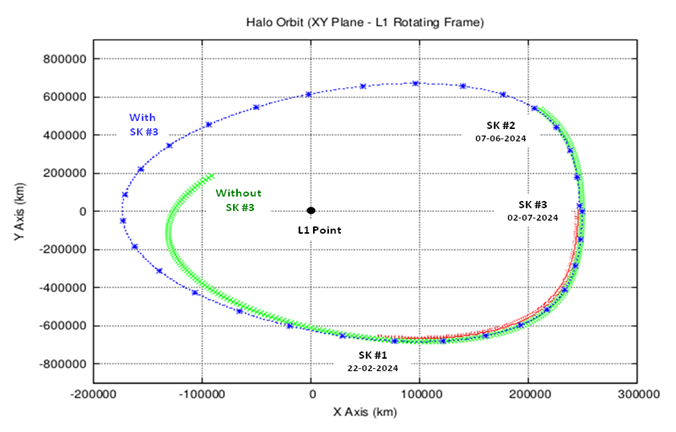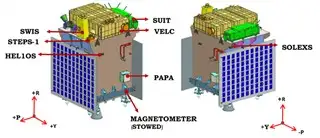Aditya-L1 Mission: Completion of First Halo Orbit

–uttarakhandhimalaya.in-
BENGALURU, 3 JULY. Aditya-L1 spacecraft has completed its first halo orbit around the Sun-Earth L1 point. The Aditya-L1 mission is an Indian solar observatory at Lagrangian point L1, launched on September 2, 2023 and was inserted in its targeted halo orbit on January 6, 2024. Aditya-L1 spacecraft in the Halo orbit takes 178 days to complete a revolution around the L1 point.
During its travel in the halo orbit, Aditya-L1 spacecraft will be subjected to various perturbing forces that will cause it to depart from the targeted orbit. It underwent two station-keeping maneuvers on February 22 and June 7, respectively, to maintain this orbit. Today’s 3rd station-keeping maneuver has ensured that its travel continued in to thesecond halo orbit path around L1.

This journey of Aditya L1 around Sun-Earth L1 Lagrangian point involves modeling of complex dynamics. The understanding of various perturbing forces acting on the spacecraft helped in determining the trajectory accurately and planning precise orbit maneuvers. With today’s maneuver, the state-of-the-art flight dynamics software developed in-house at URSC-ISRO for the Aditya-L1 missions stands fully validated.
The blue trajectory, in the figure, is the orbit around the Lagrangian point L1. This trajectory is a 3 dimensional trajectory, and what is shown is the projection of it in the X-Y plane. SK#1, 2 & 3 are the Station Keeping maneuvers by the Aditya-L1 spacecraft. The final firing of the thrusters, ie. SK#3 on July 2, placed the spacecraft back in the required orbit. If an accurate firing was not done, the spacecraft would have moved away in a trajectory shown in green colour. The X-Y axes are marked in distance of km, with Lagrangian point L1 at the origin.
Science Objectives:
The major science objectives of Aditya-L1 mission are:
- Study of Solar upper atmospheric (chromosphere and corona) dynamics.
- Study of chromospheric and coronal heating, physics of the partially ionized plasma, initiation of the coronal mass ejections, and flares
- Observe the in-situ particle and plasma environment providing data for the study of particle dynamics from the Sun.
- Physics of solar corona and its heating mechanism.
- Diagnostics of the coronal and coronal loops plasma: Temperature, velocity and density.
- Development, dynamics and origin of CMEs.
- Identify the sequence of processes that occur at multiple layers (chromosphere, base and extended corona) which eventually leads to solar eruptive events.
- Magnetic field topology and magnetic field measurements in the solar corona .
- Drivers for space weather (origin, composition and dynamics of solar wind .

